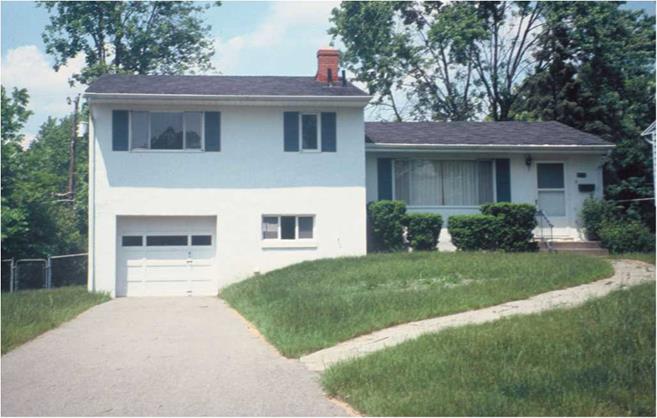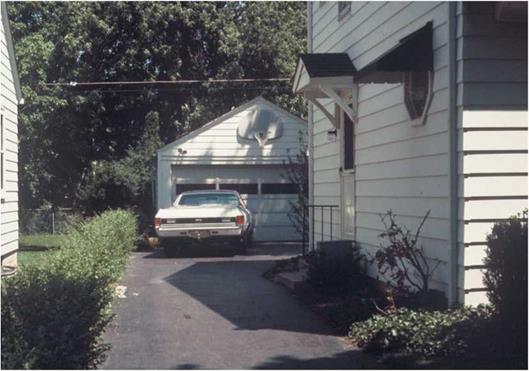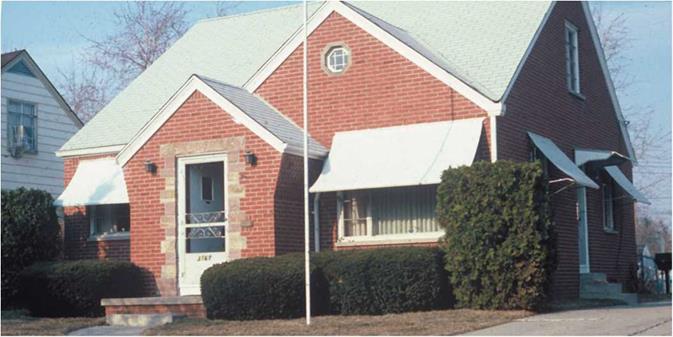The front yard of most residential sites has two primary functions: (1) it is the setting or foreground for viewing the house from the street, and (2) it is the public area for arrival and entrance into the house. In terms of its function as a setting, the front yard provides the “frame” for viewing the “picture” of the house from the street. Much attention is given to arranging plant materials along the base of the house and in the yard to establish “curb appeal.” That is, the front yard and house are attractive to look at from the street.
The front yard is also a public area where the main arrival and entry to the house are usually located. The residents of the house along with their relatives, friends, and other visitors use this public space as an introduction to the site.
Keeping these two functions in mind, let us look more closely at specific conditions of typical front yards.
1. Front Lawn Lacks Edges. On many residential sites, the house is placed near the middle of the lot in a manner that creates an open front lawn.
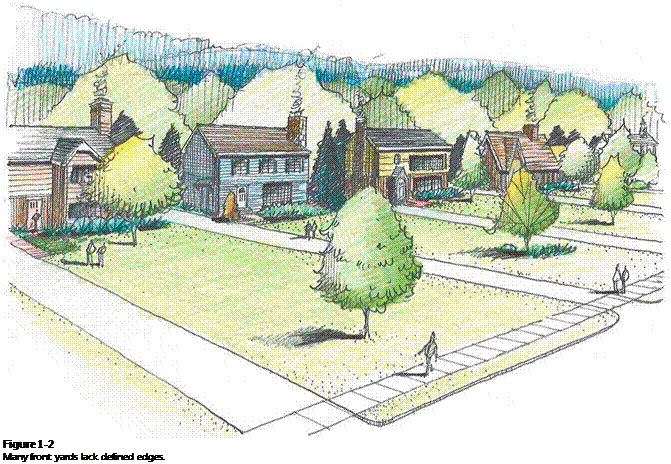
The scale of this area often gives a feeling of an anonymous “no-man’s land” because of its openness and undefined edges. This quality is frequently compounded when the front lawn of one site blends into the neighboring front lawn with no separation or division between the two (Figure 1-2).
2. Driveway Dominates View. The driveway is a dominant visual element of many front yards (Figure 1-3). This extensive area of asphalt or concrete is generally not very appealing to the eye. With cars parked in the driveway, there is often little or no room for people to walk except along the narrow edge or on the lawn (Figure 1-4). This may be acceptable in good weather but can be an inconvenience in wet weather or during the winter when snow is piled along the edges of the driveway.
3. Prominence of Garage Door. A related problem of some front yards is the prominence of the garage door. A garage door that directly faces the street and takes up a large portion of the front of the house becomes a significant visual feature of the front yard. When a driveway is lined with shrubs, the garage door is accentuated even more because a noticeable axis is formed that leads the eye toward the garage door (Figure 1-5). By comparison, the front door often seems insignificant and secondary.
4. Entry Walk too Narrow. The walk leading from the driveway to the front door is often about 3 feet wide. This dimension is narrow and forces people to walk in single-file fashion (Figure 1-6).
|
|
|

5. Entry Walk Hidden from View. Another problem of the entry walk is that it is not easily seen, especially where it connects to the edge of the driveway (Figure 1—7). In such cases, there is nothing to acknowledge or call attention to the location of the entry walk.
6. Entry Walk Lacks Visual Interest. As a person proceeds along the entry walk, there is very little visual interest. A large open expanse of lawn on one side of the walk and a wall of foundation planting on the other side (Figure 1—8) usually do not provide a memorable experience. And the walk’s pavement material often lacks a distinct character or appeal. It is simply a rather dull environment to walk through to get to the front door.
7. Entry Foyer too Small. A concrete pad or stoop located at the front door serves as the outdoor foyer or arrival area. It is often so small that no one can
|
|
|
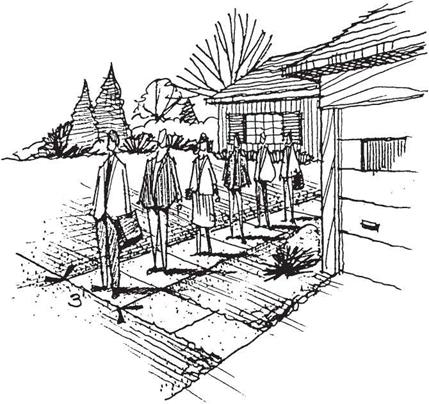
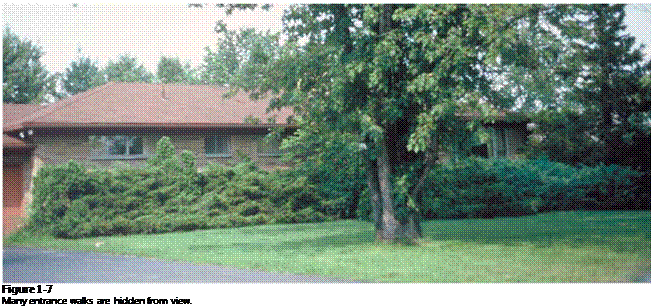 |
 |
stand on it while the storm or screen door is being opened without getting hit in the face or stepping away from the stoop (Figure 1—9).
8. Entry Foyer Lacks Enclosure. The entry area or foyer often lacks an adequate sense of separation from the street and the rest of the front yard. The stoop is often exposed directly to the street or even to the neighbor’s house across the street so that everyone can easily see the comings and goings of visitors (Figure 1—10). Also, the entry is apt to be directly exposed to such climatic elements as hot summer sun, cold winter wind, or precipitation. All of these factors make it uncomfortable for a visitor to stand for very long outside the front door.
9. Hidden Front Door. An opposite problem of some outside arrival and entry areas is that the front door is hidden from view. This most often results from overgrown plant materials screening out the view of the front door (Figure 1—11). For a first-time visitor, not knowing exactly where the front door is can be an uncomfortable and confusing feeling.
10. Foundation Planting. The use of plants in the front yard is frequently limited to foundation planting—the practice of lining the foundation of a house with a row of shrubs (Figure 1—12). These shrubs, typically evergreen
|
|
|
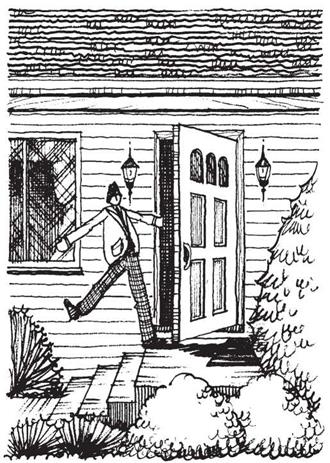
for year-round green color, are often manicured to establish such geometric forms as cubes, pyramids, and spheres (or, if you like, footballs, pop cans, ice cream cones, boxes, and so on; Figure 1—13). This visual treatment of plant materials is characteristic of historic Italian and French gardens, where plants were sheared and clipped into formal shapes to reflect the strong formal character of the gardens and the architecture.
Foundation planting has been used in the United States since the late 1800s to hide high foundation walls that resulted from houses constructed several feet above the ground to provide basements for gravity-air furnaces.
|
|
|
|
|

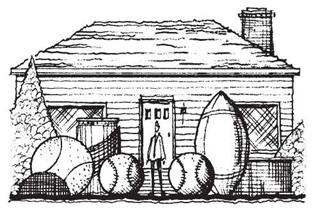
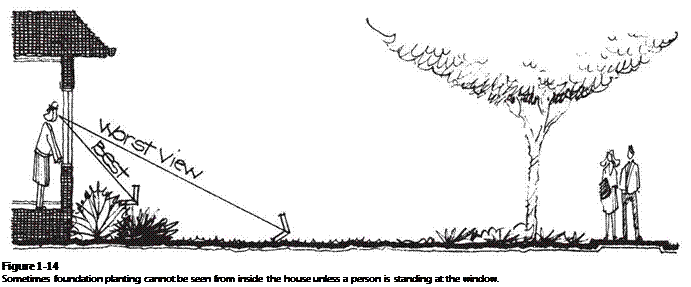
However, most contemporary houses have little or no foundation wall exposed. Another problem of foundation planting is that it is seen more by passersby on the street than by the homeowners. Foundation planting cannot be seen from within the house unless a person is standing at the window (Figure 1—14).
11. Overgrown Foundation Planting. A major problem with many foundation plantings is that they are overgrown to the point of obstructing the windows of the house and crowding adjoining entry walks. On some sites, the windows on the first floor of the house are completely covered with a mass of foliage, thus blocking out light and views to the outdoors (Figure 1—15). One reaction some homeowners have to this is to permanently close the window shades to block the view of the back of the shrubs just outside.
12. Scattered Plants in Lawn. Trees and shrubs located in the front yard are sometimes placed randomly throughout the yard so as to “fill” the lawn area (Figure 1—16). This often makes maneuvering a lawn mower like driving through an obstacle course.
13. 
Little Enjoyment of Front Yard. One overall characteristic of many front yards is that they lack a memorable image or style. Many front yards are bland, unexciting, and similar to the others in the neighborhood.
|
Figure 1-16 Plants are often located randomly in front yards in a manner that fills the entire yard. |
Most front yards are only public settings for the house and provide little opportunity for outdoor living or enjoyment by the residents. There are few places in most front yards to sit, have a cup of coffee, talk with a friend, or read a book.
The challenge is for designers to improve these conditions so that the front yard can become an attractive, useful, and inviting space on the residential site.

